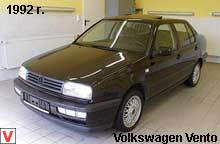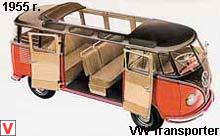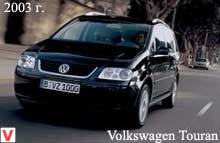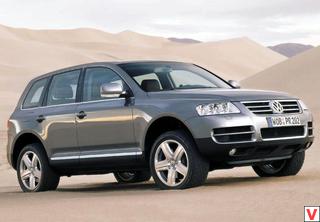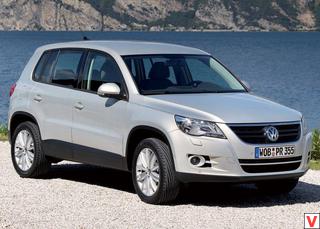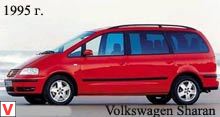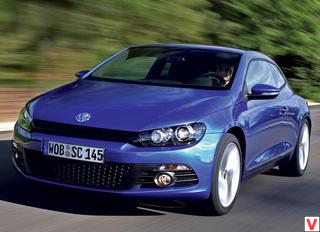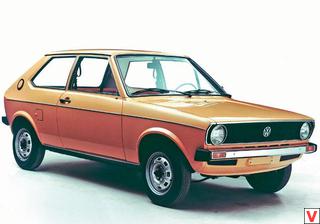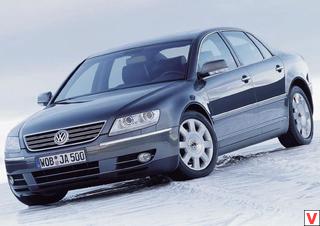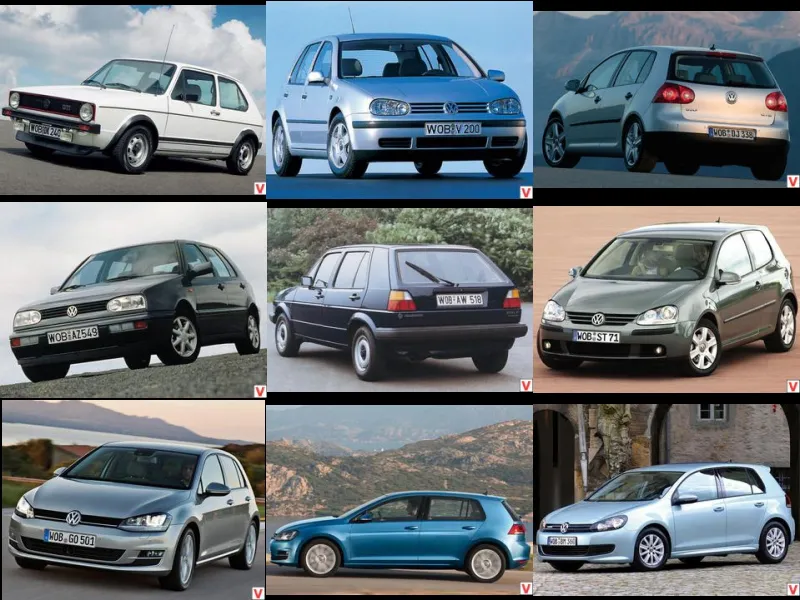
The legendary Volkswagen Golf was first introduced to the world in 1974. The car was awarded the original name in honor of the warm ocean currents - the Gulf Stream (German Golfstrom). Golf is the most successful model of the German auto giant and one of the best-selling in the world. This car marked the beginning of a whole class of cars, which was named after him.
A modest plastic trim, angular design and average comfort paid off with front-wheel drive (extremely rare at the time), a wide range of petrol and diesel powertrains, and a choice of bodies (three- or five-door hatchback, Jetta sedan and convertible). Golf was produced in two versions (basic and luxury), had a large set of options: rear window washer, “janitor”, sliding hatch in the roof, lockable fuel tank cap and wheels with alloy wheels. The base power unit was a 1.1-liter engine with a capacity of 50 liters. from. With him, the car accelerated to 90 km / h in 13.2 seconds. Maximum speed up to 149 km / h. The average fuel consumption of 8.6 liters per 100 km.
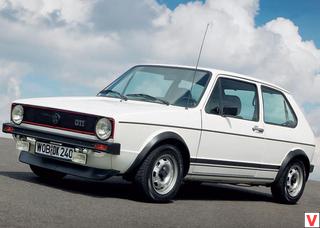
From the very beginning, customers were offered cars not only with a manual transmission, but also with an “automatic”. In the autumn of 1975, the VW Golf GTI was introduced to visitors to the Frankfurt Salon. The sports version of the model, which combines the cost of a compact car and the dynamics of a sports coupe. The GTI version was distinguished by black window frames, sport seats and a steering wheel, wheel space frames widened with plastic overlays and a number of other details. The main driving force was the 1.6-liter engine with the K-Jetronic fuel injection system. The motor had a power of 110 horsepower at 6100 rpm.
This made it possible to develop a speed of 100 km / h in 9 seconds, and its maximum speed was 183 km / h. Cars with the GTI nameplate began to enjoy particular demand in the market, so as early as 1976 the Golf Diesel GTI appeared, equipped with a 1.5 liter turbodiesel with a capacity of 50 hp. In 1979, Volkswagen introduces the Golf-convertible with a folding soft top. The body was made by renowned atelier Karmann from Osnabrück.
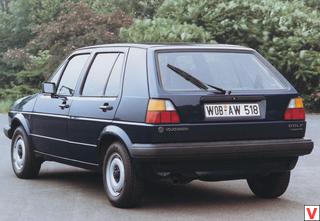
The release of the Golf I cabriolet stretched from 1980 to 1993, right up until the appearance of the Golf III. This was due to the fact that in the period when the production of the Golf I was already stopped and changed to the Golf II, the convertible version of the Golf II never appeared. The release of the Golf I was stopped in 1983.
During the production of the first model in Germany, about 5,625,000 cars were produced, including about 450,000 in the GTI version. In the United States and Canada, it was produced under the trademark “Volkswagen Rabbit”, and in Latin America - “Volkswagen Caribe”. The second generation Golf saw the light in August 1983. The car has become larger. The length has increased by 300 mm, width by 55 mm, the interior has become more spacious and comfortable. A more advanced body shape reduced the air resistance coefficient from 0.42 for the previous model to 0.34. The main features of the car Volkswagen experts have been preserved, but at the same time supplemented and improved.
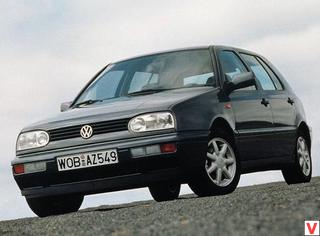
A set of gasoline and diesel engines from 1.1 to 1.8 liters with a capacity of 50 to 90 hp was proposed, the gearbox was mechanically stepped and automatic. The generation Golf II turned out to be generous with modifications. In 1984, the GTI model appeared with an 8-valve engine producing 112 hp. Maximum speed up to 186 km / h and acceleration to 100 km / h in 9.7 s. In 1985, the range expands the legendary GTI 16V (139 hp).
Sales of the Golf GTI II surpassed sales of the first generation GTI and accounted for 17,193 cars in 1989. All-wheel-drive Golf Syncro appeared in 1986. But the most striking addition to the family was the appearance in 1989 of the all-wheel drive version of the Golf II Country. The Golf Syncro’s body and units are mounted on the frame here, thanks to which the car has an impressive ground clearance, while, like the Syncro, Country has a viscous coupling in the rear axle drive, which allows the rear wheels to automatically connect when the front wheels slip. This modification was assembled at the Steyr plant in Graz (Austria).
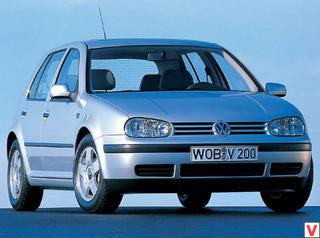
The model did not find wide demand from the high price, just over 7,000 pieces were produced. In the late 80s, VW was experimenting with mechanical supercharging. As a result, the “charged” Volkswagen Golf G60 is equipped with a 160-horsepower 1.8-liter engine.
Golf II was produced not only in factories in Germany, but also in France, the Netherlands, Great Britain, Spain, Austria, Switzerland, Finland, Japan and the USA. Volkswagen continued to produce the Golf II until 1992. 6.3 million copies rolled off the assembly line. The debut of the third generation Golf took place in August 1991 at the Geneva Motor Show. The choice of bodies included: three-door and five-door hatchbacks, a Golf Variant station wagon, and a convertible. The luggage compartment of the station wagon with the rear seats folded down was 1,425 liters. Golf III received a unique design and a much more spacious interior.
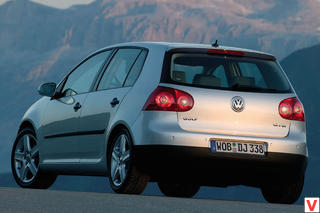
Among the additional equipment, you can highlight the ABS system, electric heating of the seats, air conditioning, electric adjustment of the angle of inclination of the seat backs, centralized control of locks, electric adjustment of the exterior mirrors, engine preheating system during cold weather and much more. The range of engines includes seven petrol (60 hp 1.4 l., Up to the powerful VR6 12V with a capacity of 2.9 l. / 190 hp) and three diesel engines (two atmospheric 64 and 75 hp and one turbocharged 90 hp). All gasoline engines were equipped with converters.
The most "modest" engine had a volume of 1.4 liters, and the most powerful one - 2.8 liters (with such a car, it developed a speed of 225 km / h, and the "hundred" gained from a place in 7.6 seconds). The most powerful versions received a four-stage automatic transmission with electric hydraulic drive, equipped with two programs - for economical and sporty driving styles, as well as disc brakes on all wheels (front ones - ventilated). All cars were completed with power steering and brakes. In 1995, a unique VW Golf appears with a 2.8-liter VR6 engine under the hood.
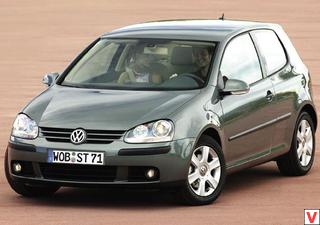
The concept of the VR6 was to take an ordinary V6 and change the angle between the two cylinders by 15 degrees so that all the pistons fit under one cylinder head. The 2.8-liter VR6 delivered 172 horsepower. The developers paid special attention to safety - volumes appeared easily crushed upon impact, reinforced frame, amplifiers built into the doors. Also on the Golf III there were airbags for the driver and front passenger, deformable by 170 mm steering column, foam-covered instrument panel and steel rear seat backs. Plus, the creators of the Golf III gave their customers a 12-year warranty against rust corrosion.
Golf III sold in the amount of 4.8 mil. copies and its production ceased in 1997. "Fourth" Golf, whose production began in 1997, has become a more comfortable and expensive car with a rich list of options. Without coordinating change, the designers managed to give the car a modern look.
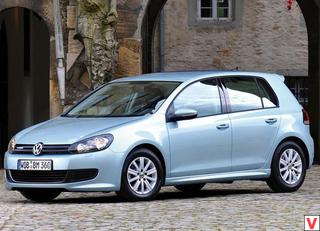
First of all, unusual light devices attract attention. Under the common glass cap there are two large dipped and high beam headlights, as well as two small round lights of the direction indicator and the fog light. The rear part of the car has noticeably changed, a characteristic element of which is now the curved rear roof pillar, which passes into the wing. New sound-absorbing materials and new engine mountings and exhaust systems were used. There are four equipment levels for the Golf IV: Trendline, Comfortline, Highline and GTI. Having kept the general proportions, Golf IV became more.
Its length increased to 4149 mm (+131 mm), width - up to 1735 mm (+30 mm), and the base - up to 2511 mm (+39 mm). The list of standard equipment is impressive: ABS, frontal airbags for the driver and passenger, two side airbags in the backside of the front seats, disc brakes on all wheels (front ventilated), power steering with variable gear ratio and power on the steering wheel, height adjustable seat driver, dust filter air in the ventilation system, rear head restraints, body-colored bumpers, grille and exterior mirrors. On request, the client can install a navigation system with an LCD display on the center console.
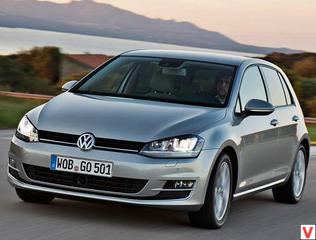
There are things that were not previously installed on cars of this class. For example, the rain sensor monitors the intensity of the wipers. The range of engines includes six petrol and three diesel engines with a capacity of 68 to 180 hp. The fifth-generation Golf was unveiled at the Frankfurt Motor Show in September 2003. The car is built on the newest platform, which also formed the basis of the Audi A3 II generation and VW Touran. Together with her, the car also received a multi-link rear suspension, and in addition - a new body, the rigidity of which increased by 80%. The Golf V is 57 mm (4204 mm) longer, 24 mm (1759 mm) wider and 39 mm (1483 mm) taller.
The first to increase the space will feel the rear passengers: legroom increased by 65 mm, and the ceiling rose by 24 mm. Trunk volume has grown to 347l. The silhouette of the model is defined by five main elements: a belt line running under the side windows and noticeably rising upwards, a clear graph of side windows forming a single whole, embossed side panels in the area of the rear doors and pillars, the characteristic shape of the rear pillar, angled, and a swift roofline . Absolutely new front end with improved aerodynamics.
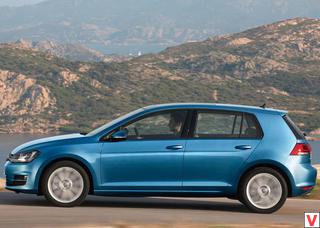
Dual round headlights with transverse direction indicators, like the Phaeton, characteristically "taper" to the center of the front. Above the headlamps rise the relief curved surface of the wings. As a continuation of the bonnet along with the grille, they form a V-shaped form. The car’s interior is German, functional, and very ergonomic: all functional levels are clearly separated, all buttons and switches are in place. Every detail compared to the previous model has been refined and improved.
For example, the center console with devices located on it: here the controls of the audio / navigation system and the ventilation / air conditioner are higher, so they are better visible and easier to control. The design of the front seats is fully updated, they provide maximum comfort. The Golf V is the first car in its segment in which a seat with an electrically adjustable lumbar support, operating in four modes (integrated in the seat), or with an independent action heater, is optionally offered.
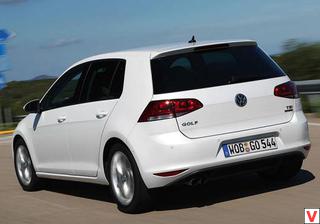
In addition to the serially installed rear seat, the backrest of which is folded in parts in the proportion of 60:40, the front-passenger seat with a folding backrest is offered as additional equipment, thereby extending the cargo area and it is possible to transport items of great length. For Golf V there are several options for engines and gearbox. Diesel line is represented by two units: 2.0 l / 140 hp and 1.9 / 105 hp The choice of gasoline engines is much more: 1.6 l. / 102 hp, 1.4 l / 75 hp, 1.6 l / 115 hp The car can also be equipped with 1.4TSI units (three versions - 122, 140 and 170 hp), 2.0 FSI (two versions - 150 and 200 hp).
Golf V will be offered in 3 versions of basic equipment: Trendline, Comfortline and Sportline, differing in some details of the finish. Each of them already includes 6 airbags, ABS with brake assist system and ESP. In the summer of 2009, the presentation of the sixth generation of the car. The length of the Golf VI is 4199 mm, which is 5 mm less than the previous model. On the other hand, the car has become wider by 20 mm, at the same height. The whole look of the Golf VI speaks about its sporting character. The front of the body draws attention to the grille and the elegant shape of the headlights.
A pronounced line extending from the headlights to the rear lights visually pulls the body and makes the car lower. Inside, high-quality design elements are pleasing to the eye, including chrome-plated applications, numerous decorative inserts in the front panel and door upholstery. The white illumination of the received design of the devices is also nice to the eye. The climatic installation is included in the standard package. The new Golf is equipped with a variety of safety systems: new generation ESP, skid prevention system, ABS with brake assist, MSR, trailer stabilization system and ASR traction control.
The manufacturer took care of the safety of both the driver and all passengers and installed seven airbags, and one of them protects the driver's knees. Powertrain car remained the same. The basis is 1.6 liter engine, which runs on gasoline, and has a capacity of 102 horses. There is also a 1.39 liter turbo unit with 122 or 160 horsepower. As well as manufacturers took care of diesel engines with a 2.0 liter turbo unit, which develops power of 110 or 140 hp. Traditionally, powertrains for Volkswagen are characterized by low fuel consumption and develop excellent power. The new 7-speed DSG gearbox provides comfortable gear shifting without interrupting power flow.
It is worth emphasizing the sports version of the Golf GTI. Its 2.0 TSI engine develops 155 kW (210 hp), accelerating the car from 0 to 100 km / h in 6.9 seconds (maximum speed of 240 km / h). With such indicators, fuel consumption remains acceptable - 7.3–7.4 l / 100 km. The choice is also automatic 6-speed DSG, or traditional mechanics.
The seventh generation Volkswagen Golf was officially unveiled at the 2012 Paris Motor Show. The new generation, as usual, has become more spacious, easier and more economical. Contrary to expectations, the chief designer of the concern Walter da Silva, known for his bold work, did not dare to radically change the design of the model.
But minor improvements were enough for the Golf VII to acquire modern features, to become more attractive and dynamic. Retaining the main features of the style, according to which this brand will be recognized, the seventh Golf has changed its geometrical dimensions. The car was 56 mm longer (4255 mm), 13 mm wider (1799 mm) and 28 mm lower (1,452 mm) of its predecessor. The wheelbase was extended by 59 mm (up to 2637 mm), which allowed the passenger compartment to be stretched by 14 mm and the space in the legs of the rear passengers by 15 mm.
It became more spacious and in the shoulders: at this level, the interior has expanded by 30 mm. The driver’s landing went down by 2 cm, the gas and brake pedals were moved apart by 16 mm and the steering angle was increased. The extended trunk added in a volume of 30 liters (up to 380 liters), and its loading height decreased by 17 mm. The continuity of generations in the VW Golf family is a non-negotiable concept, but at the “seven” you will not find a single common body panel with a sixth generation car. This car is really completely new. He has a more dynamic silhouette due to the reduced height of the body and slightly elongated roof.
It has more sharp edges, and the headlights with LED sections are now peeking out from under the boned edges of the hood. The lowered roof gave the car not only a dynamic look, but also improved aerodynamic characteristics. Despite the increased width of the body, the drag coefficient became smaller. Thanks to the use of the latest modular platform MQB, Volkswagen designers managed to reduce the vehicle weight by 100 kg. The body is lightened by 23 kg, the engines and new seats became lighter, 3 kg won due to the modified wiring, another 26 kg of weight was dropped by the suspension.
German engineers fought for every gram, realizing that reducing the weight of the car would reduce fuel consumption. Volkswagen AG Chairman Martin Winterkorn set a task for his subordinates to radically improve the fuel efficiency of the model. As a result of the work done, the car consumes 23% less fuel, and Volkswagen Golf 1,9 TDI BlueMotion became the apotheosis of the struggle for fuel efficiency. This turbocharged diesel engine produces 110 hp. and 250 N * m torque with a five-speed manual transmission consumes only 3.2 liters of fuel per 100 kilometers.
This result was achieved with the help of the “start-stop” system, the installation of tires with reduced rolling resistance, and the braking energy recovery system. The height of the BlueMotion suspension was reduced by 15 mm, and additional aerodynamic elements were installed on the body to improve engine cooling and reduce drag. In addition to this power unit, the range of diesel engines is represented by engines of 90, 150 and 180 horsepower. The TSI gasoline family includes: 1.2-liter (105 hp), 1.4-liter (122 hp) and 1.4-liter (140 hp). A more powerful version of the model with the prefix GTI has a gasoline turbocharged unit with a volume of 2.0 liters and a capacity of 220 horsepower.
Transmission to choose from - 6-speed manual transmission or 7-speed “automatic” DSG. As for the suspension, the front of the seventh generation Volkswagen Golf McPherson, and two types of rear suspension: for modifications with engines weaker than 125 horsepower, a semi-dependent beam is provided (it is smaller, lighter and cheaper), and for all other versions it has a multi-lever. A lot of new electronic systems appeared in the car. The equipment will include an adaptive cruise control with an automatic braking function, a circular video review system, a marking tracking system, as well as a “recognizer” of road signs and a driver fatigue detector.
The classic "handbrake" will give way to the electronic, and the steering will receive five modes of operation (Eco, Sport, Normal, Individual and Comfort). The list of options also includes an adaptive suspension. Whether the adaptive suspension will appear in Russia is not yet clear.
